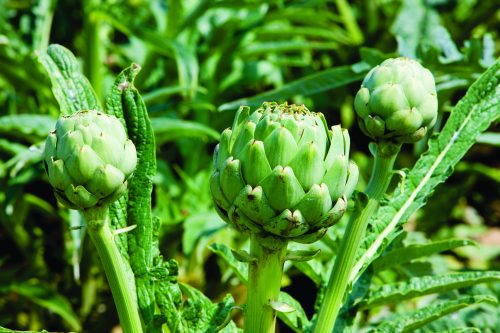
This unopened flower bud is perfect for decorative and edible purposes.
Originating from the Mediterranean, the globe artichoke is an eye-catching, silvery-green, thistle-like plant producing striking purple flower heads which dry well for displays. The immature green flower head also makes a delicious starter.
Globe artichokes can be raised from seed quite easily but they may produce prickly, low-yielding plants. Now is the time to beg for or buy rooted suckers (side shoots) to plant.
An established globe artichoke plant can grow over one metre tall, two metres wide and will take over the flower or vegetable bed, so give it plenty of space! A good plant will last about six years producing suckers for replanting – a lifetime’s supply of globes.
Planting tips
- Plant your suckers one metre apart in a loose, well-composted and manured soil. With regular watering they will grow rapidly.
- Apply a thick mulch of straw or wood chippings in summer to conserve moisture, and keep feeding with manure tea fortnightly.
- If flower heads appear in the first year, remove them – the plant needs to establish growth not fruit during adolescence. Snails also enjoy artichokes so be vigilant in their removal.
Over winter, protect the fleshy plant from frost by covering with fine netting or plenty of straw and then leave in a dormant state. Come the following spring, remove the covering, start feeding and watering again and look for the main flower bulb in the centre of the plant. Cut this – leaving a 10cm stalk on the bulb end – when it is swollen and still closed. Secondary, smaller heads will appear if the plant is given plenty of manure – these are good for eating, too.
To cook artichokes, cut off the stalk, remove outer scale leaves and boil the head in salted water or steam for 30 minutes. The traditional way to eat globe artichokes is to pull off the scales, dip in butter, hollandaise sauce or a vinaigrette and pull through the teeth to scrape off the flesh at the base of each. This leaves a fleshy heart for the knife and fork and the hairy centre (the choke) which should be discarded.
www.healthyfood.com










